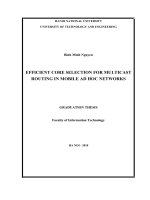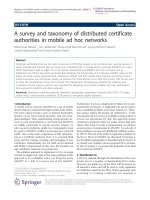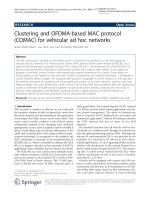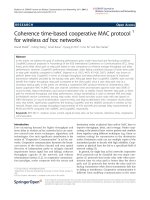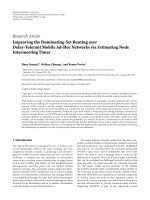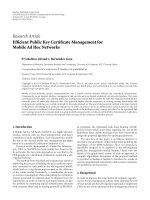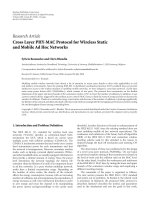Medium access control and energy efficient routing for mobile ad hoc networks
Bạn đang xem bản rút gọn của tài liệu. Xem và tải ngay bản đầy đủ của tài liệu tại đây (615.87 KB, 114 trang )
MEDIUM ACCESS CONTROL AND ENERGY-EFFICIENT
ROUTING FOR MOBILE AD-HOC NETWORKS
CHENG JING
(B.Eng., Xi’an Jiaotong University, China)
A THESIS SUBMITTED
FOR THE DEGREE OF MASTER OF ENGINEERING
DEPARTMENT OF ELECTRICAL AND COMPUTER ENGINEERING
NATIONAL UNIVERSITY OF SINGAPORE
2003
ii
ACKNOWLEDGEMENTS
I have had a great honor to be supervised by Dr. Winston Seah. I would like to take
this opportunity to acknowledge his scientific guidance and support.
I would like to thank for all the people with whom I have had valuable discussions,
who gave me comments or suggestions on my research work.
I would like to thank my parents, for always being there for me. My parents have
given me love and support all the time, and without them this thesis would not have
been possible.
iii
TABLE OF CONTENTS
ACKNOWLEDGEMENTS ........................................................................................... ii
TABLE OF CONTENTS .............................................................................................. iii
LIST OF FIGURES ....................................................................................................... vi
LIST OF TABLES ....................................................................................................... viii
SUMMARY .................................................................................................................... ix
CHAPTER 1
INTRODUCTION............................................................................... 1
1.1 Overview and Motivation ..................................................................................... 1
1.2 Thesis Contributions ............................................................................................. 5
1.3 Thesis Organization .............................................................................................. 6
CHAPTER 2
MOBILE AD HOC NETWORK (MANET) .................................... 8
2.1 Characteristics and Requirements of MANET ..................................................... 8
2.1.1
Limited Energy Source ............................................................................. 8
2.1.2
Topological Changes .............................................................................. 10
2.1.3
Low and Variable Channel Capacity ...................................................... 11
2.1.4
Large Scale Deployment......................................................................... 11
2.2 Village Radio Network Overview ...................................................................... 14
CHAPTER 3
A SURVEY OF AD HOC ROUTING PROTOCOLS .................. 16
3.1 General Concepts ................................................................................................ 16
3.1.1
Link-State Routing.................................................................................. 16
3.1.2
Distance-Vector Routing ........................................................................ 17
3.1.3
Source Routing........................................................................................ 18
3.1.4
Flooding .................................................................................................. 19
3.1.5
Unicast and Multicast ............................................................................. 20
3.2 MANET Routing Protocols ................................................................................ 20
3.2.1
Protocol Overview and Classification .................................................... 20
3.2.2
On-demand Routing Protocols................................................................ 23
iv
3.2.3
Dynamic Source Routing (DSR) ............................................................ 26
3.2.4
Ad Hoc On-Demand Distance Vector Routing ...................................... 28
CHAPTER 4
MULTI-HOP TDMA-BASED MAC PROTOCOL....................... 32
4.1 Overview of Village Radio Network .................................................................. 32
4.2 Multi-hop TDMA-based MAC Protocol ............................................................ 33
CHAPTER 5
VILLAGE RADIO ROUTING PROTOCOL (VRRP) ................. 41
5.1 Protocol Overview .............................................................................................. 42
5.2 Route Cache Management .................................................................................. 44
5.3 Route Discovery.................................................................................................. 44
5.4 Route Maintenance ............................................................................................. 50
5.5 Route Deletion .................................................................................................... 52
5.6 Protocol Operation Summary ............................................................................. 53
CHAPTER 6
SIMULATION MODEL DESIGN.................................................. 54
6.1 Network Simulator Overview ............................................................................. 54
6.2 Physical Layer Model ......................................................................................... 57
6.3 Medium Access Control ..................................................................................... 58
6.4 Address Resolution ............................................................................................. 59
6.5 Interface Queue................................................................................................... 60
CHAPTER 7
SIMULATION
STUDIES
AND
PERFORMANCE
COMPARISONS ................................................................................................... 61
7.1 Performance Metrics ........................................................................................... 62
7.2 Simulation Study I .............................................................................................. 62
7.2.1
Simulation Model.................................................................................... 63
7.2.2
Simulation Results .................................................................................. 64
7.3 Simulation Study II ............................................................................................. 68
7.3.1
Simulation Model.................................................................................... 68
7.3.2
Performance Evaluation in Low Mobility Scenarios.............................. 71
7.3.3
Performance Evaluation in High Mobility Scenarios ............................. 83
7.3.4
Comparison and Summary...................................................................... 95
CHAPTER 8
CONCLUSION AND FUTURE WORK ........................................ 99
v
8.1 Conclusion .......................................................................................................... 99
8.2 Future Work ...................................................................................................... 101
REFERENCE.............................................................................................................. 102
vi
LIST OF FIGURES
Figure 4.1: (a) Layout of the TDMA frame and (b) Details of one data slot.................. 35
Figure 4.2: An example of the TDMA-based MAC protocol......................................... 38
Figure 5.1: The formations of reverse path and forward path. ....................................... 48
Figure 5.2: VRRP Operation........................................................................................... 53
Figure 6.1: Schematic of a mobile node under ns-2 ....................................................... 56
Figure 7.1: Percentage of packets successfully delivered as a function of the number
of nodes in the network................................................................................ 65
Figure 7.2: End-to-end delay as a function of the number of nodes in the network...... 65
Figure 7.3: Normalized routing message overhead as a function of the number of
nodes in the network .................................................................................... 66
Figure 7.4: Average energy consumption per node as a function of the number of
nodes in the network .................................................................................... 67
Figure 7.5: Performance of VRP and VRRP as a function of traffic load in low
mobility scenarios. ....................................................................................... 73
Figure 7.6: Fraction of successfully delivered data packets as a function of traffic load
in low mobility scenarios. ............................................................................ 75
Figure 7.7: End-to-end delay as a function of traffic load in low mobility scenarios. ... 78
Figure 7.8: Normalized routing message overhead as a function of traffic load in low
mobility scenarios. ....................................................................................... 81
Figure 7.9: Average energy consumption per node as a function of traffic load in low
mobility scenarios. ....................................................................................... 83
Figure 7.10: Performance of VRP and VRRP as a function of traffic load in high
mobility scenarios ........................................................................................ 85
Figure 7.11: Fraction of successfully delivered data packets as a function of traffic
load in high mobility scenarios. ................................................................... 87
Figure 7.12: End-to-end delay as a function of traffic load in high mobility scenarios. 89
Figure 7.13: Normalized routing message overhead as a function of traffic load in
high mobility scenarios. ............................................................................... 92
vii
Figure 7.14: Average energy consumption per node as a function of traffic load in
high mobility scenarios. ............................................................................... 95
Figure 7.15: Comparisons of the performances of VRRP in low and high mobility
scenarios as a function of traffic load .......................................................... 98
viii
LIST OF TABLES
Table 2.1: Characteristics of MANET and the consequential requirements on routing
protocols....................................................................................................... 14
Table 3.1: Comparisons of the characteristics of table-driven routing protocols ........... 22
Table 3.2: Comparisons of the characteristics of on-demand routing protocols ............ 23
Table 5.1: Route Cache................................................................................................... 44
Table 5.2: Route Reply ................................................................................................... 49
Table 5.3: Route Error .................................................................................................... 52
Table 7.1: Constants used in the VRRP simulation-I ..................................................... 64
Table 7.2: Constants used in the VRRP simulation-II.................................................... 70
ix
SUMMARY
A mobile ad hoc network (MANET) is an autonomous system of mobile nodes that
are connected by wireless devices without any fixed infrastructure support or any
form of centralized administration. In such a network, nodes are able to reach
destinations beyond their direct wireless transmission range by routing the packets
through intermediate nodes. This characteristic requires each mobile node to operate
not only as a host but also as a router, with a basic multi-hop routing capability, and
must be willing to forward packets for other nodes.
Village radio system [1] is a kind of wireless ad hoc network, which is
characterized by mobile nodes and relays, low and variable channel capacity, and
dynamic topology due to node mobility. The original routing algorithm for village
radio system is simply a classical flooding mechanism, where every village radio
terminal retransmits each message when it receives the first copy of the message.
Simultaneous transmission of the same packet by multiple users is allowed, while
neither signal collision nor contention will cause a receiving problem in village radio
system. This is achieved by exploiting the broadcast nature of radio waves and
enabling the receiving terminal to combine the individual signals to produce a
stronger signal instead losing the information due to interference. However, the
network-wide flooding is highly energy-consuming which will quickly drain the
village radio terminals’ limited energy resources, thus we developed a new routing
algorithm for village radio system.
We present an innovative source-initiated on-demand routing to exploit the
robustness of the village radio system while significantly reducing the energy
consumption. This protocol, Village Radio Routing Protocol (VRRP), does not
x
introduce any new messages e.g. route request (RREQ) packet in route discovery;
routers can infer routes from broadcast messages. The protocol operates in an energyefficient manner by minimizing flooding of messages after nodes have learned routes
from messages, and eventually stop flooding after a route has been established. To
support the new routing protocol, we also enhanced the village radio’s time division
multiple access (TDMA) based medium access control (MAC) protocol. Our
simulation results show that this enhanced MAC protocol performs better in the
village radio network than the IEEE 802.11 MAC protocol does. Our simulation
results also show that this new routing scheme is quite suitable for original floodingbased village radio network, which no existing ad-hoc routing protocol can be used.
This routing scheme is also effective as it provides fairly high packet delivery at both
high and low mobility settings. Furthermore, this routing scheme is energy-efficient
as it substantially reduces packet flooding.
In addition, we have carried out simulations to compare the performance of VRRP
with popular ad hoc routing protocols, e.g. AODV and DSR. We show that our
routing protocol VRRP exhibits a significant reduction in routing overhead, and
provides a considerable amount of energy saving over AODV and DSR.
CHAPTER 1
1.1
INTRODUCTION
Overview and Motivation
Due to rapid technological advances in wireless data communication devices and
laptop computers, wireless communications between mobile users is becoming more
indispensable than ever before, and wireless networks have become increasingly
popular since 1970s. Their main advantages are the mobility that they offer and the
flexibility of installation in places where a wired network cannot be easily deployed.
There are currently two variations of mobile wireless networks. The first is known as
the infrastructure network, i.e. a network with fixed and wired gateways while the
other is the infrastructureless mobile network, commonly known as a mobile ad hoc
network (MANET).
A MANET is an autonomous system of mobile nodes that are connected by
wireless
devices
without
any
fixed
infrastructure
support
or
centralized
administration. MANETs are also known as Self-Organizing networks, which are
rapidly deployable with dynamic topology and do not depend on wired network
infrastructures. In such a network, nodes are able to reach destinations beyond their
direct wireless transmission range by routing the packets through intermediate nodes.
This characteristic requires each mobile node to operate not only as a host but also as
a router, with a basic multi-hop routing capability.
MANETs are developed to operate in a wide variety of environments, from
military scenarios or emergency rescues (with hundreds of nodes) to low-power
sensor networks (with potentially, thousands of nodes). MANETs have mostly been
CHAPTER 1. INTRODUCTION
2
used in the military sector, while successful examples of ad hoc radio networks in the
commercial sector are few so far. Now, researchers turned to the small-scale personal
area networks, instead of the large-scale networks. That is, the products will mainly
focus on facilitating communication between a user’s personal devices. The ad hoc
network functionality will also enable the interconnection of different users’ devices.
In a MANET, routers can be mobile. The network topology can change, and
likewise, the addressing within the topology can change. In this paradigm, an end
user’s association with a mobile router determines its location in the MANET. Due to
the fundamental change in the composition of the routing infrastructure, (that is, from
fixed, hard-wired, and bandwidth-rich to dynamic, wireless, and bandwidthconstrained), the routing algorithms must be reworked.
MANETs have several characteristics that differentiate them from fixed multi-hop
networks.
•
Dynamic topologies – since nodes are free to move arbitrarily, the network
topology, which is typically multi-hop, may change randomly and rapidly at
unpredictable times.
•
Energy-constrained operation – some or all of the nodes in a MANET may
rely on batteries for energy, making power conservation a critical design
criterion for these nodes.
•
Bandwidth-constrained, variable capacity, and possibly asymmetric links –
the network has low capacity, especially when the mobility is high. Another
effect is that MANETs often operate in heterogeneous wireless environment
with significantly varying bandwidth-delay characteristics.
•
Wireless vulnerabilities and limited physical security – while there are existing
CHAPTER 1. INTRODUCTION
3
link-layer security techniques, a lot of work is still needed on security.
This study focuses on routing protocol research and development on MANETs.
Traditional networks (both mobile and non-mobile) have been designed for lowdelay, high-throughput, and scalability. These are the criteria for designing mobile ad
hoc networks too. In addition, MANETs require a routing protocol to be simple, loopfree, quick to converge and low in overheads. Thus, many challenges prevail in
designing a routing protocol for MANETs. Some of these problems are listed as
below,
•
Lack of centralized entities
•
Rapid node movementÆ changing network topology
•
Wireless communications
•
Limited battery power/transmission range of some nodes
•
Reliability, survivability and availability
Generally, routing in mobile ad hoc networks (MANETs) is challenged by mobility
and dynamics of mobile devices. New routing protocols for MANETs are required
because classical routing algorithms cannot cope with constant topology changes in
such networks and the use of wireless media. All nodes in MANETs are capable of
movement and can be connected dynamically in an arbitrary manner. There are no
fixed routers in these networks; nodes function as routers, which discover and
maintain routes to other nodes in the network. They also have the ability to
reconfigure and reorganize when the network topologies change.
The numerous routing protocols proposed for mobile ad hoc networks over the last
few years are generally classified into two categories: table-driven and demanddriven, with those possessing characteristics of both, referred to as hybrid protocols.
CHAPTER 1. INTRODUCTION
4
Table-driven routing protocols try to maintain consistent, up-to-date routing
information from each node to every other node in the network. Examples of tabledriven routing protocols are Destination-Sequenced Distance-Vector routing protocol
(DSDV) [3], Clusterhead Gateway Switch Routing protocol (CGSR) [4] and Routing
Protocol (WRP) [5]. However, table-driven routing is inefficient because of excessive
routing messages from the periodic exchange of updates among the nodes. Several
studies have confirmed this [2][8].
Unlike table-driven routing, demand-driven routing creates routes only when
desired by the source node. Examples of reactive routing protocols are Ad Hoc OnDemand Distance Vector (AODV) routing [6], Dynamic Source Routing (DSR) [7],
Location-Aided Routing (LAR) [9], and Signal Stability based Adaptive Routing
(SSA) [10]. Essentially, these protocols search for a route by flooding a route request
packet to the network. When the search target or an intermediate node with a cached
route hears the request, it replies by sending a route reply packet to the source. Ondemand protocols have been found to generate less routing overhead and higher
packet delivery as compared to table-driven protocols [2][8] , e.g. DSR and AODV
have consistently fared well in many simulation studies [2]. However, they still
introduce additional control packets in route discovery, which is the major cause for
increasing routing overhead. When the network topology keeps changing very quickly
due to high mobility of nodes in the network, the overhead will increase drastically.
Although numerous routing protocols have been presented, there is not a particular
algorithm or category of algorithms which can work best for all MANET scenarios.
Each routing protocol has advantages and disadvantages, and fits well for certain
situations. Hybrid protocols combine the techniques of table-driven and demanddriven protocols trying to obtain an optimal solution.
5
CHAPTER 1. INTRODUCTION
Since most mobile ad hoc networks are battery-operated systems, they are energy
and bandwidth constrained. Power and energy efficient design becomes one of the
most important design concerns for MANETs. Low energy consumption extends
battery’s lifetime, reduces the cost for system maintenance, and increases the system’s
lifetime when recharging or replacement is not possible (e.g., military networks in a
battlefield or sensor networks). Thus, we want to reduce control messages in route
discovery, which leads to smaller routing overheads and savings in energy
consumption. Consequently, mobile nodes can last longer, which is a big advantage in
many applications of MANETs, and is particularly important for military uses.
This thesis concentrates on achieving energy-efficient unicast routing in multi-hop
wireless ad hoc networks. The goal of the energy-efficient routing protocol is to
increase the life of mobile nodes and the network. Moreover, we have worked on
cross-layer
design
for
ad-hoc
wireless
networks,
which
deals
with
designing the layers of the network jointly to improve the system. The idea that we
have is that the power control, signal design, transmitter and receiver design in the
physical layer, and scheduling in MAC layer should interact with routing in the
networking layer. In this study, we have addressed both MAC and network layers,
with cross-layer research instead of focusing on one layer. By doing so, we obtained a
more efficient solution for our target network. Lastly, this thesis also included the
goal to generate a simulation model that could be used as a platform for both current
and further studies within the area of ad hoc networks.
1.2
Thesis Contributions
In this study, we develop a source-initiated on-demand routing protocol aimed at
CHAPTER 1. INTRODUCTION
6
not introducing any new messages in route discovery in a village radio network. This
thesis makes three important contributions.
- Presented in [27], a novel routing protocol, Village Radio Routing Protocol (VRRP),
that fits well for village radio network is proposed. In addition, by implementing the
MAC protocol, Village Radio Protocol (VRP) [1], routing-layer design complexity
and energy wastage are reduced.
- The new Village Radio Routing Protocol (VRRP), as presented in [27] and further in
chapter 5, is one of the first attempts to not introduce any new messages in route
discovery.
- Presented in [27], a simulation model has been set up, and simulation studies have
been performed to gauge the performance of the new routing protocol. It shows that
VRRP has greatly improved energy efficiency at a small price of slightly lower packet
delivery ratio and higher end-to-end delay. In addition, by using implicit route
discovery, the routing overhead in the network is substantially reduced.
1.3
Thesis Organization
The rest of the thesis is organized as follows. In chapter 2, the basic and most
important requirements of mobile ad hoc networks are discussed. In Chapter 3,
several general concepts on mobile ad hoc networking are introduced, followed by a
survey of current MANET routing protocols. In the next chapter, we first introduce
our target scenario, i.e. the village radio network. Then we describe the medium
access control for village radio network, which is a multi-hop Preamble based Time
Division Medium Access protocol. In chapter 5, we present the routing protocol. A
CHAPTER 1. INTRODUCTION
7
description of our simulation tool is presented in chapter 6. The simulation models
and results are given in chapter 7. Finally, we will state our conclusions and further
work to be done to optimize this new protocol.
CHAPTER 2
2.1
MOBILE AD HOC NETWORK (MANET)
Characteristics and Requirements of MANET
Mobile Ad hoc Networks differ from conventional wireless networks in several
ways. In conventional wireless networks, nodes are connected to a wired network
infrastructure and only the last hop is wireless. In MANETs, which are also known as
Self-Organizing networks, a wired network infrastructure is not available. With their
own routing protocols and network management mechanisms, MANETs are multihop wireless networks where nodes are also routers, and rapidly deployable with
dynamic topology. In this section, we will discuss the important characteristics and
requirements of MANET. Later, in the next chapter, we will assess several existing
MANET routing protocols based on these requirements.
2.1.1 Limited Energy Source
In a wireless mobile ad hoc network, energy is a critical resource for batterypowered nodes. A node may have only limited energy capacity, but may be required
to function for a longer period of time and do considerable computing work. This
severe limitation makes it crucial for the routing protocol to be highly energy-efficient.
In other words, nodes must consume the least amount of energy possible while still
delivering fairly high percentage of traffic to the end-user. Low energy consumption
extends battery’s lifetime, reduces the cost for system maintenance, and increases the
network’s lifetime when battery recharging or replacement is not allowed (e.g.,
military networks in a battlefield or sensor networks). Consequently, mobile nodes
CHAPTER 2. MOBILE AD HOC NETWORK (MANET)
9
can last longer, which is a big advantage in many applications of MANETs, and is
especially important for military uses. Several solutions to minimize energy
consumption at the network layer have been proposed and they are discussed below,
•
Minimize Routing Overhead.
Routing overhead can be in the form of periodic route updates for table-driven
routing algorithms, route discovery packets for on-demand routing, or any other
form of traffic that is intended for routing purposes. As transmission consumes
energy, minimizing the routing overhead must be one of the goals of routing
protocols to conserve energy. On-demand protocols have been found to generate
less routing overhead and higher packet delivery as compared to table-driven
protocols [2][8]. However, they still introduce additional control packets in route
discovery, which is the major cause for increasing routing overhead. When the
network topology keeps changing very quickly due to high mobility of nodes in
the network, the overhead will increase drastically. Thus we want to further
reduce control messages in route discovery, which leads to smaller routing
overhead and more savings in energy consumption.
•
Power-Off Radio When Idle.
According to the IEEE 802.11 standard, a wireless interface can be in awake state,
doze state or off state [20] – we may say that a node is in a certain state, when its
wireless interface is in that state. In the off state, the wireless interface consumes no
power. Similarly, in the doze state, a node cannot transmit or receive, and consumes
very little power. In the awake state, a node may be in one of three different modes,
namely, transmit, receive, and idle modes, and consumes somewhat different power in
each mode. The motivation of this approach is due to the fact that a significant
CHAPTER 2. MOBILE AD HOC NETWORK (MANET)
10
amount of energy is consumed even in the idle mode, i.e. when there is neither
transmission nor reception of network layer packets occurring. This is due to the
CSMA/CA (collision avoidance) mechanism in IEEE 802.11, which requires each
awake node to continually listen to the channel. However, directly manipulating the
radio transceiver from the network layer may not be an elegant approach considering
the design difficulty of routing protocol and device complexity of nodes. It is more
appropriate to implement the radio switch-off process at the MAC layer where it can
be efficiently coordinated with the channel access algorithm. It has been demonstrated
that turning off radios intelligently at the MAC layer can reduce overall energy
consumption by approximately 50% [17].
2.1.2 Topological Changes
In a MANET environment, wireless nodes are expected to move, enter or leave the
network randomly, thus breaking of connectivity is anticipated every now and then.
When nodes come into radio range of one another, new connections are established.
Therefore, the topology of the network changes from time to time.
The depletion of energy in nodes can cause topological changes too. When a node
dies out, it cannot participate in the routing process resulting in disconnections. A
routing protocol for mobile ad hoc networks must therefore be designed to be robust
against topological changes. One possible solution is to discover and store more than
one route to a destination during route discovery, and later when one route breaks, the
packets can be routed via alternative routes. Multi-path routing can reduce the
frequency of route discovery and increase the robustness of a protocol against
topological changes. Consequently, the routing overhead caused by route discovery
CHAPTER 2. MOBILE AD HOC NETWORK (MANET)
11
can be decreased but the maintenance cost of multiple routes in terms of routing
packets need to be considered to achieve a complete evaluation of the routing
overhead [15].
2.1.3 Low and Variable Channel Capacity
To minimize energy consumption due to transmissions, nodes will have a very low
channel capacity. For example, the PicoRadio project estimates that a future
PicoNode will have a very low data rate, between 1 to 10 bits per second [16]. As a
result, communication overhead must be minimum to fully maximize the channel
capacity. Asymmetric links are also anticipated; hence, the protocol must also provide
support for these kinds of links.
2.1.4 Large Scale Deployment
The capability to extend the mobile ad hoc network is determined, partially, by the
scaling characteristics of the routing protocols used. Large-scale deployment of the
network requires the routing protocols to be scalable. From a technical standpoint,
routing protocols scale well if their resource use grows less than linearly with the
growth of the network.
To address scalability, the routing protocols can fall into three classes: flat routing,
hierarchical routing, and geographic position information assisted routing approaches
[18]. The flat routing protocol can be further divided into two categories, namely,
proactive routing and on-demand routing. Unfortunately, most flat routing schemes
only scale up to a certain degree. Proactive routing protocol maintains consistent, upto-date, global routing information in the network, and stores it in routing tables.
CHAPTER 2. MOBILE AD HOC NETWORK (MANET)
12
When wireless network size and mobility increase (beyond certain thresholds), on one
hand, excessive routing update overhead is generated due to frequent exchanges of
routing information network wide, resulting in over consumption of the bandwidth.
Consequently, data traffic is blocked, rendering it unfeasible for bandwidth limited
wireless ad hoc networks. Similarly, routing table size grows linearly with network
size. Both the high routing storage and processing overhead make it impossible for
flat proactive routing schemes to scale well to large network size. Reactive or ondemand routing protocols are intended to remedy the scalability and routing overhead
problems since they only require nodes to establish and maintain routing information
when needed. Thus, reactive routing protocols exhibit lower storage and processing
overhead even in very large networks as long as mobility is low and traffic is light. In
a large network with highly dynamic node movement and heavy traffic load to many
different destinations, however, reactive routing can incur huge amounts of flooding
packets in search of destinations and leads to very high routing control overhead. In a
network of 100 nodes and 40 sources with uniform traffic pattern, the results in [19]
show that both DSR and AODV generate more routing overhead than actual
throughput. It has clearly shown the scalability problem of the reactive routing
protocols.
Typically, when wireless network size increases (beyond certain thresholds),
current flat routing schemes become infeasible because of large storage and
processing overhead. Thus reducing routing control overhead becomes a key issue in
achieving routing scalability. One possible solution is by making the routing
algorithm hierarchical. An example of hierarchical routing is the Internet hierarchy,
which has been practiced in wired network for a long time. Wireless hierarchical
CHAPTER 2. MOBILE AD HOC NETWORK (MANET)
13
routing is based on the idea of organizing nodes in groups and then assigning nodes
different functionalities inside and outside of a group. Both routing table size and
update packet size are reduced by including in them only part of the network (instead
of the whole), thus control overhead is reduced. The most popular way of building
hierarchy is to group nodes geographically close to each other into explicit clusters.
Each cluster has a leading node (cluster head) to communicate to other nodes on
behalf of the cluster. The major advantage of hierarchical routing is the drastic
reduction of routing table storage and processing overhead [18]. But there is one
potential problem of hierarchical routing, that is, some leading nodes (cluster heads)
may actually lose energy more quickly than other non-special nodes. Thus
hierarchical routing may run into conflict with the energy-efficiency requirements of
MANET.
Geographic position information assisted routing approaches use location
information for directional routing to reduce routing overhead. The storage overhead
is also limited to a small table for storing routing and location information of
neighbors. Nonetheless, additional overhead for location services (including location
registration and location databases lookup) [18] is introduced and must be considered.
In general, network scalability is limited by: control and storage overhead, degree of
mobility, network density, and traffic load. We summarize the important
characteristics and requirements relevant to the network layer or routing protocol
design in Table 2.1.
14
CHAPTER 2. MOBILE AD HOC NETWORK (MANET)
Table 2.1: Characteristics of MANET and the consequential requirements on routing protocols
Characteristics
Limited energy source
Topological changes
Low and variable channel capacity
Large scale deployment
2.2
Requirements
(1) Minimize routing overhead
(2) Power-off radio when idle.
Multiple routing
(1) Minimize routing overhead and
packet header
(2) Support asymmetric links
Scalable routing:
(1) Flat routing
(2) Hierarchical routing
(3) Geographic poison information
assisted routing
Village Radio Network Overview
Village radio network [1] is a kind of wireless ad hoc network, which is
characterized by mobile nodes and relays, low and variable channel capacity, and
dynamic topology due to node mobility. In this study, we concentrate on three main
layers: the physical, media access control (MAC), and network layers. A physical link
is created between two radios for communication. The physical layer handles the
communication across this physical link, which involves modulating data onto the
medium in a way that can be demodulated by the intended receiver. Next, the MAC
layer provides the service of coordinating the access to the medium, since many
radios coexist in the same radio frequency environment where signals can interfere
with each other. Above the MAC layer, the network layer resolves the path for a
packet to take, when nodes that are not within physical radio range of each other wish
to communicate, through other nodes that forward packets on their behalf. This
forwarding of packets is often referred to as multi-hop networking, and the nodes
doing so are referred to as routers. In village radio network, active terminals in the
CHAPTER 2. MOBILE AD HOC NETWORK (MANET)
15
network will act as routers, and rebroadcast signals from neighbors to extend their
range.
The uniqueness of village radio network [1] is that signals are allowed to take
multiple paths through the network simultaneously without distorting them. After a
signal has passed through the multi-path network, the receiving node can combine the
individual signals to produce a stronger signal instead of losing the information due to
interference. Therefore, the signal arriving at the destination is a composite of the
signals from various paths. Though innovative, energy consumption had not been a
requirement of the initial design. Large-scale deployment of village radio network
also needs to be addressed to determine network scalability.
